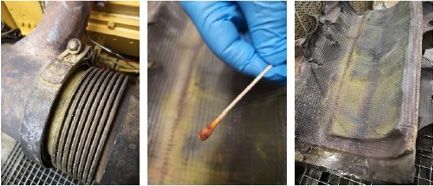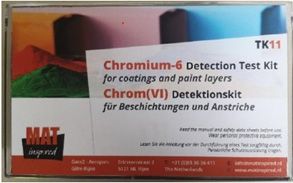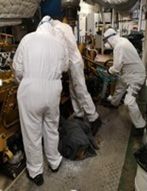Hexavalent Chromium or Chromium 6 (Cr-6) on engines
KEY POINTS
Cr-6 was identified as yellow, solid and non-volatile deposit that can be observed on some exhaust manifolds and exhaust thermal insulations.
Cr-6 is the result of the transformation of Cr-3 and Cr-4 contained in the alloy of stainless steel parts. This reaction is favored by high temperatures (exhaust circuits) in oxidizing environment.
Eneria’s investigations has shown that these deposits are not volatile. Thus, the main identified hazard for operator is the physical contact with these parts and the Cr-6 deposit on them.
Apart from the direct operation on the exhaust manifolds, there is no risk for the health of the technical staff during the standard engine maintenance. Therefore, no specific preventive measures are required during daily operations.
On the other hand, in case of operation on exhaust manifolds with the potential risk of contact with Cr-6, it is recommended to use the personal protection measures, (implemented at Eneria) such as full single-use protective suit, gloves, waterproof eyes protection and FFP2 or FFP3 respiratory protection (single-use mask).
We provide you with the Risk assessment to help you update your global HSE plan and with the Caterpillar Technical Information Bulletin that we ask you to integrate into your engine’s Operation and Maintenance Manual.
FAQ – THEMES
- 1/ Introduction: Cr-6 presence on engines
- 2/ Who is concerned
- 3/ Cr-6 in the ambient air of the machine room or power plant
- 4/ Caterpillar position
- 5/ Preventive measures
- 6/ Parts clean-up
1/ Introduction: Cr-6 presence on engines
What is Hexavalent Cromium or Chromium-6?

Hexavalent Cromium or Chromium-6 (Cr-6) is the product of the oxydation of Cr-3 or Cr-4 contained in the alloy of certain stainless steel parts from the exhaust system and/or its thermal insulation. Cr-6 develops under specific conditions: high temperature, oxydising environment, potential presence of catalyst, such as Calcium, present in some greases.
Cr-6 is usually present as solid, non-volatile yellow powder that clumps on exhaust manifolds.
CR6 is one of the proven carcinogenic, mutagenic and reprotoxic components. Cr-6 can be dangerous in case of direct skin or/and eyes contact and/or inhalation.
It is a product of a chemical reaction that occurs during operation of the engine. It is not initially present on the new engines.

How does the Chrome 6 develop?
This oxidation reaction is favoured by a temperature above 400 °C (exhaust circuits) in an oxidising environment (ambient air). The presence of a catalyst such as Calcium enhances the Cr-6 formation.
Where Cr-6 can be found ?
Cr-6 can be found on engine parts affected by high temperature (over 400°C), mainly on bellows, bellow collars, exhaust manifold screws (nut/bolt), on thermal insulation inner face and on turbocharger.

What are the regulations?
Below, the official recommendations:
- Protect yourself from the danger,
- Stay below the Exposure Limit Value (Professional Exposure Limit Value / Short term limit value),
- If technically possible, find a solution to avoid the Cr-6 formation,
- As per Labour code of France: “We must replace what is dangerous with what is less dangerous, and what is a little dangerous, with what is not dangerous”
French regulations:
Professional Exposure Limit Value (8h): 1µg/m3
Short-term limit value (15 minutes): 5µg/m3
Our various studies show that, apart from the direct operation on the exhaust manifolds, the technical staff operating around the engine is not exposed to the contact with the Cr-6. Therefore, no specific preventive measures are required.
Moreover, ambient air contamination measurements show that the Professional Exposure Limit Values are not exceeded.
2/ Is my engine concerned?
How can I verify the presence of Cr-6 on my engine?
It is possible to confirm it by using an instantaneous detection kit, with a swab to rub suspected surfaces and with a revealing product that changes color if Cr-6 is present.

Which engines are concerned?
ENERIA has conducted these tests mainly on marine engines and gas generator sets, as these engines operate more than 1000 hours per year. At present, according to the tests results, we can confirm that Cr-6 was detected on the following series:
- Gas engines: G3500 C, E and H and CG260,
- Diesel generator sets: C175
- Marine Diesel Engines: 3516C
We prefer to remain cautious in our conclusions about these results. The only way to verify if your engine is concerned, is to conduct the test.
3/ Presence of Cr-6 in the ambient air of the engine room or in power plant room
What kind of analyses have been conducted?
In order to go further in our investigations, Eneria have mandated two official Control Offices. Several ambient air contamination measurements have been conducted under different operating or maintenance conditions:
- Engine in normal operating condition (engine running or engine stopped);
- Engine in maintenance situations (works on exhaust manifolds; with or without the thermal exhaust insulation).
These measurements were conducted in the facilities, where engines had been tested as positive at the swab test with the instantaneous detection kit. These investigations showed that Professional Exposure Limits Values are not exceeded. Moreover, the real measured values does not exceed 15% of the Professional Exposure Limits Values.
Professional Exposure Limit Value (8h): 1µg/m3
Short Term Limit Value (15 minutes): 5µg/m3
What is the result of these analyses?
Our various studies show that, apart from the direct operation on the exhaust manifolds, with or without the room ventilation, the technical staff operating around the engine is not exposed to contact with the Cr-6.
However, the direct operation on the exhaust manifold may result in creation of airborne dust containing the yellow deposit. There is a risk of direct contact with Cr-6 deposits or a risk of inhalation. Thus, we recommend personal protection measures are as follows:
- Full single-use protective suit,
- Nitrile protective gloves, if necessary doubled with other protective gloves,
- Waterproof eyes protection,
- FFP2 or FFP3 type respiratory protection (single-use mask).
4/ What is Caterpillar’s position on Cr-6?
Is Cr-6 present on the new engines from the factory?
CATERPILLAR confirms what follows:
- No, Cr-6 is the product of an oxidation reaction that occurs under high temperature while engine is running. Cr-6 is not initially present on the new engines, coming directly from the factory.
- Cr-6 may be encountered on certain Caterpillar engines in-use, it may also come from sources such as aftermarket parts, interactions with maintenance materials and/or certain operating environments.
- Cr-6 may be present as yellow residual deposit, typically in areas of high heat such as exhaust manifolds or exhaust thermal insulation.
- New CATERPILLAR engines comply with current regulations, including REACH standards on chemicals.
Does CATERPILLAR plan to replace the concerned parts?
No, the replacement of these components is not planned by Caterpillar, especially because it would not provide a definitive solution.
What is the position of Occupational health doctor?
As soon as the Cr-6 issue had been identified, Eneria informed local Occupational Health Department.
All Eneria investigations results have been communicated in order to assess the personal protection measures to be taken by employees. The efficiency of personal protections already deployed at Eneria, and described below, has been validated by the Occupational Health Department.
5/ Personal protection measures
What are the personal protection measures put in place by ENERIA?
In case of direct operation on the exhaust manifolds there is a potential risk of contact with deposits or inhalation. Thus, the recommended personal protection measures are following:
- Full single-use protective suit,
- Nitrile protective gloves, if necessary doubled with other protective gloves,
- Waterproof eyes protection,
- FFP2 or FFP3 type Respiratory protection (single-use masks).

What are the preventive measures for my staff?
No special action is to be taken as long as technical staff is providing standard engine maintenance. In case of an intervention on exhaust manifolds, the personal protection measures described above are required.
What should I do about my site’s Global Risk Assessment/HSE Plan?
We provide you with a Cr-6 Risk assessment with the steps you need to take to protect your staff from Cr-6 risk. This risk assessment shall be added to your Global HSE Plan. As this change is provided by ENERIA, it is not necessary to re-sign it.
Additionally, we provide you with the Caterpillar’s Technical Information Bulletin “Hexavalent chromium has been detected in certain Caterpillar engines“. This bulletin shall be added to the user Operations and Maintenance Manual as a Safety instruction supplement.
6/ Parts clean-up
Which process to follow to clean up the contaminated parts?
When ENERIA team carry out maintenance on exhaust manifolds, the following clean-up process is implemented:
- Wear «Cr-6 specific» Personal Protective Equipment (full single use protection suit, eyes protection, mask and gloves),
- Remove thermal insulation if present,
- Test the presence of Cr-6 with the detection swab test Kit,
- If the test is negative, the technical staff is no longer required to wear « Cr-6 specific » Personal Protective Equipment for the rest of the procedure,
- If the test is positive, technical staff must keep the « Cr-6 specific » Personal Protective Equipment listed above, while cleaning the contaminated parts. The HSE cleaning procedure of 26/11/19 includes:
- Clean the fixed parts with a dampened clean cloth,
- Use Branch washing machine for removable parts cleaning,
- Collect, store and dispose the contaminated wastes.
The clean-up process shall be re-conducted as long as the test remains positive.
This process can take from 1 to 3 days, depending on the engine series. CATERPILLAR identified a product (10% citric acid, 10% Ascorbic acid and 80% distilled water) that transforms Cr-6 into a more stable and non-toxic Cr-3. When tested, Eneria will integrate this solution into the cleaning processes, depending of the results.
Can Cr-6 reappear after the clean-up?
At this stage, there is not enough information to confirm it, however we suppose that the chemical transformation of Cr-6 will continue. As long as Cr-6 development conditions are met – temperature, oxidation – a risk of Chromium transformation might remain.
Is it required to change the high-temperature mounting grease?
Yes, it is required to change it only if your grease contains Calcium. As previously described, Calcium acts as a catalyst in the Cr-6 chemical reaction.
ENERIA is looking for a commercial calcium-free solution for high temperature screws greasing. The reference of these greases will be communicated as soon as possible. Old Calcium greases shall be removed.

